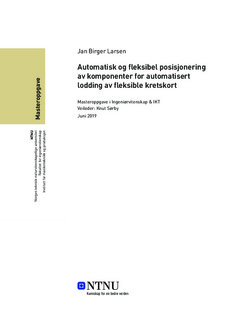| dc.contributor.advisor | Sørby, Knut | |
| dc.contributor.author | Larsen, Jan Birger | |
| dc.date.accessioned | 2019-10-10T14:00:52Z | |
| dc.date.available | 2019-10-10T14:00:52Z | |
| dc.date.issued | 2019 | |
| dc.identifier.uri | http://hdl.handle.net/11250/2621459 | |
| dc.description.abstract | Denne masteroppgaven dokumenterer utviklingen av en metodikk for ˚a posisjonere fleksible kretskort p˚a stive kompositter med hensyn p˚a mange sm˚a (< 1 mm) loddepunkter. Gjennom oppgaven har det ogs˚a vært foretatt et delstudium p˚a posisjoneringsnøyaktighet og oppløsning p˚a en UR10 industrirobot. Oppgaven g˚ar først igjennom teknologivalgene som ble gjort. S˚a g˚ar oppgaven igjennom de forskjellige fasene med utviklingen og hva slags metoder som ble testet, samt hva slags løsning som ble utviklet konseptuelt, og implementasjon og fysisk testingen av denne. Til slutt legger oppgaven ut for hvordan løsningen s˚a ut ved oppgaveslutt, den fysiske oppsettingen, brukergrensesnittet, dokumentasjon og diskusjon av koden brukt og dens hensikt, samt til slutt en evaluering av prosjektets situasjon ved oppgaveslutt, og noen tanker om hva som bør gjøres videre skulle man ønske˚a fortsette utvikling p˚a løsningen som er diskutert i denne oppgaven. Ved oppgaveslutt ble det gjennomført noen tester av posisjonering med miksede resultater, i noen tilfeller traff posisjonering ganske bra, i andre tilfeller ikke. Rapport-forfatter er optimistisk til at etter noen endringer i utstyr, og noe videre utvikling for ˚a luke ut noen ”bugs”, kan løsningen brukes. | |
| dc.description.abstract | This masters thesis document the development of a method to position flexible circuits on stiff composites with regards to many small (< 1 mm) soldering points. During this master project there was also performed a smaller study on the positioning accuracy and resolution of a UR10 industrial robot. This thesis first documents the choices of technology made for the project. Then the thesis documents the various phases of development and the different kind of methods that were tested, as well as the solution conceptually, and the implementation and physical testing of this solution. Finally the thesis documents how the problem solution was at the end of the assignment, its physical setup, its user-interface, documentation and discussion of the code used and its intended use, as well as a final evaluation of the state of the project at the end of the assignment, and some thoughts on what should be do next if it is desirable to continue developing the solution discussed in this thesis. By the end of project, testing of the positioning yielded mixed results, in some case rather accurate positioning, in other causes not. The author of this rapport is optimistic that with some changes in equipment, and some further development to remove bugs from the code, the solution could be used. | |
| dc.language | nob | |
| dc.publisher | NTNU | |
| dc.title | Automatisk og fleksibel posisjonering av komponenter for automatisert lodding av fleksible kretskort | |
| dc.type | Master thesis | |
